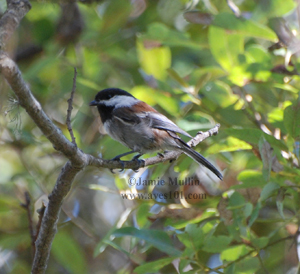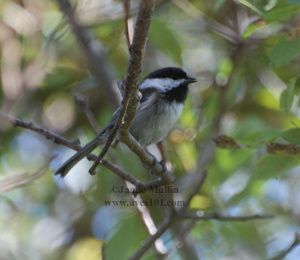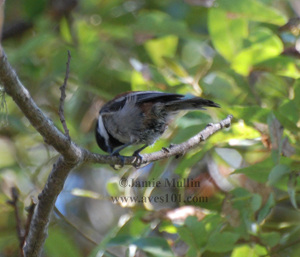Chestnut-backed Chickadee
Order: Passeriformes
Family: Paridae
Genus: Poecile
Species: rufescens
**Audio Coming Soon**
Description
-
Length: 4.75"
-
Wing span: 7.5"
-
Weight: 0.34 oz (9.7 grams)
-
Small, short billed bird with a brownish-black cap and bib with white cheeks
-
Back is a deep rufous-chestnut color
-
Unstreaked back, whitish underparts, black bill & a rather long tail
-
Wings and tail are brownish gray, flanks are rufous to grayish & the upper wing feathers have white edging
-
Sexes as well as juveniles are silimar in plumage
Factoids:
- The common chickadee of the Pacific Coast, the Chestnut-backed Chickadee is the smallest member of its family in America. It lacks a whistled song, but makes up for this deficiency by the complexity of its "chick-a-dee" calls
- The Chestnut-backed Chickadee uses lots of fur in making its nest, with fur or hair accounting for up to half of all the material in the hole. The hair from rabbits, coyote, and deer is most common, but hair from skunks, cats, horses, or cows will be used as well. The adults make a layer of fur about 1 cm (0.4 in) thick that they use to cover the eggs when they leave the nest
- Hole-nesting birds tend to have higher nest success rates than open-cup nesters, but that doesn't mean that they are immune to predation. Chestnut-backed Chickadee nests get attacked by a number of predators, including mice, squirrels, weasels, snakes, and even black bears
- The Chestnut-backed Chickadee is not truly migratory, but it does make some seasonal movements. In late summer some birds move to higher elevations up mountains. They move back to lower elevations when winter starts. In some winters, some chickadees will make local movements out of areas with deep snow
All photographs and audio clips are ©Jamie Mullin 2006
Sources: Cornell Lab of Ornithology & The Sibley Guide to Birds.
 |
|---|
 |
 |